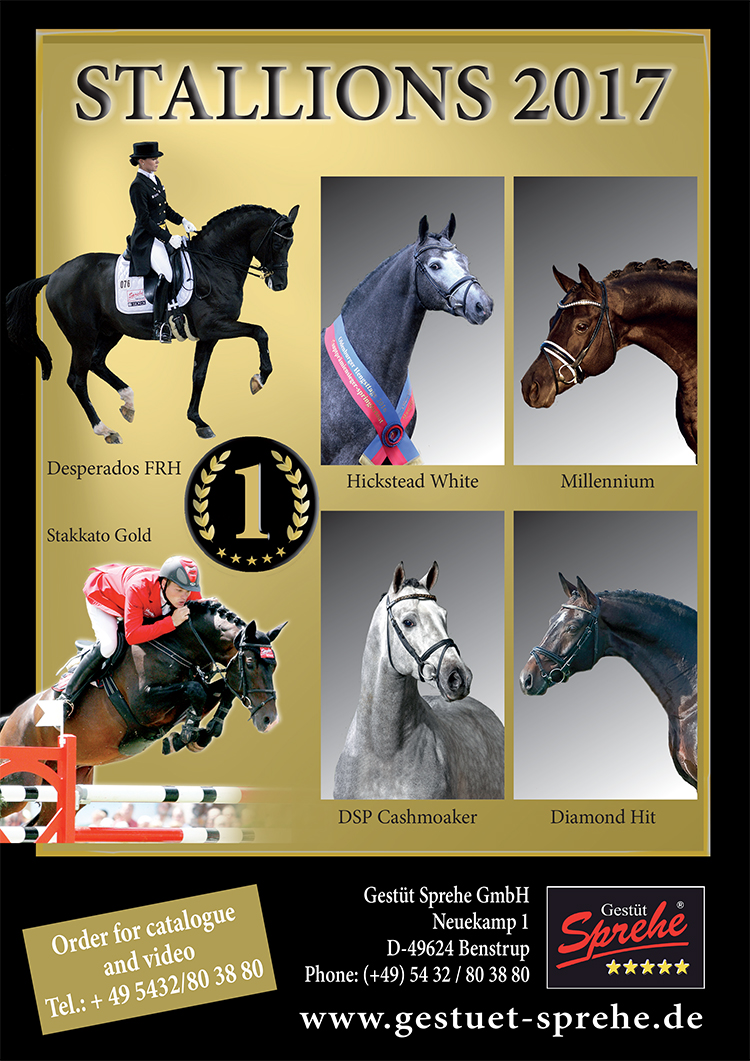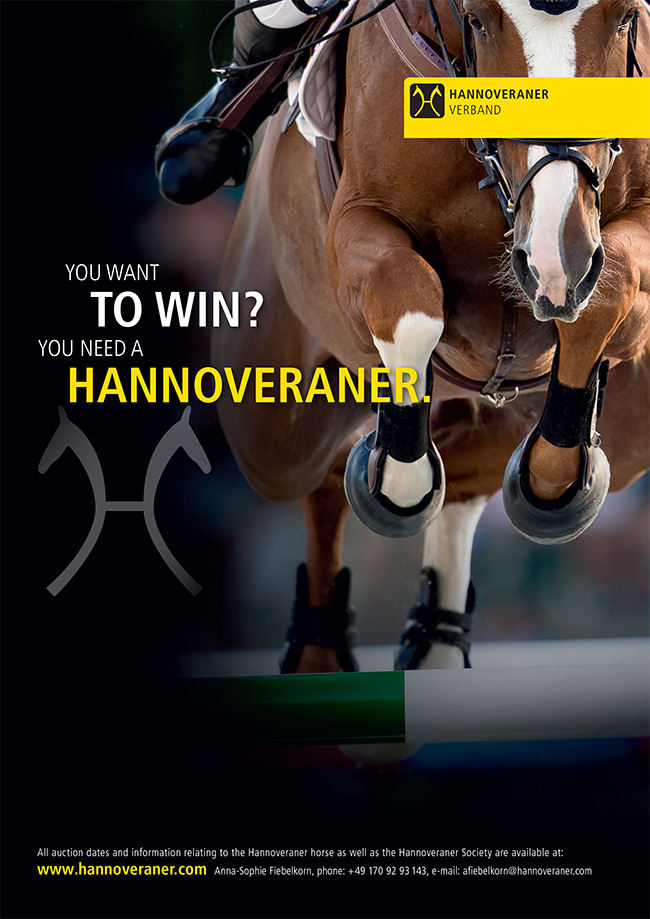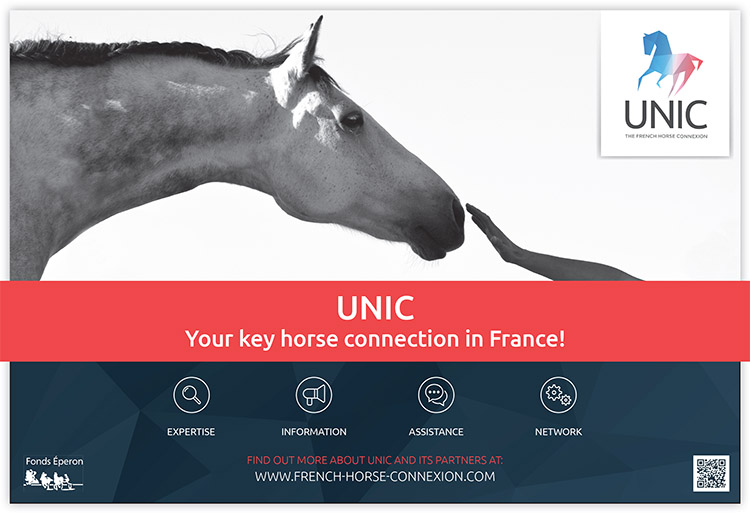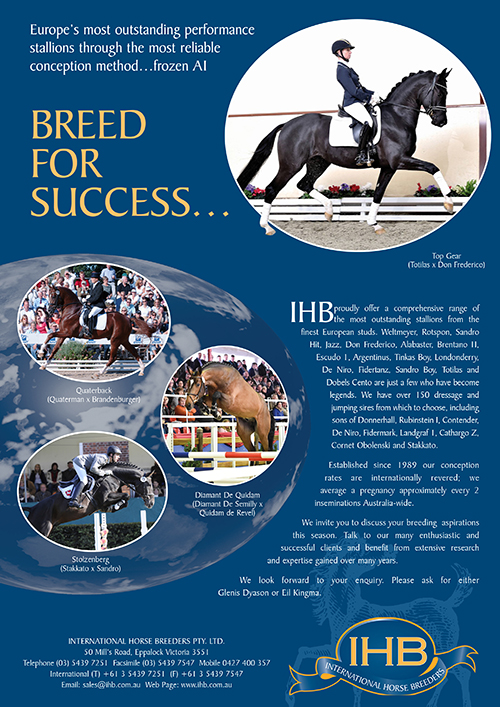Who's Who
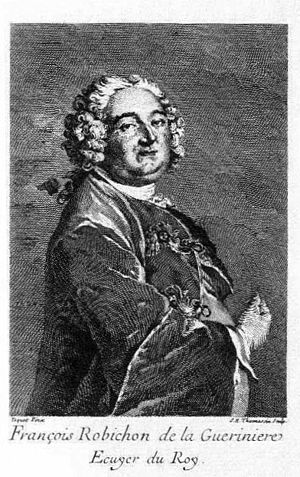
de la Guérinière, François Robichon
Discipline : Dressage
Born : 1688
Died : 1751
The founding father of Classical Dressage, de la Guérinière was a pupil of Antoine de Vendeuil. In 1715, de la Guérinière was granted the title, écuyer de roi, and opened a riding school in Paris.
At his school, de la Guérinière, not only taught riding but ‘the complete science of the horse’ and his most famous work, École de Cavalerie spends many pages describing the care of the horse. In 1750, he appointed Director of the Académie des Tuileries.
Unfortunately like many a horseman, la Guérinière was not a great businessman, and struggled to run his academy profitably, and he died in 1751 in straightened circumstances.
What can we learn from de la Guérinière?
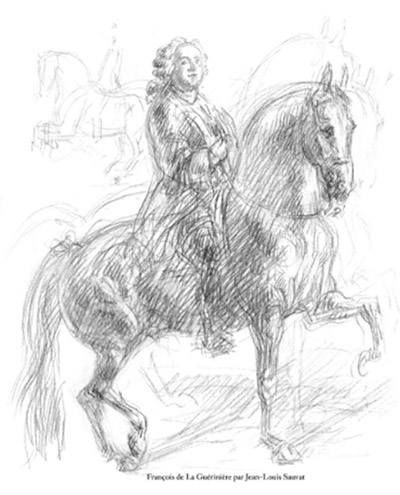
This drawing by Jean-Louis Sauvat is from the text, La Guérinière by Marion Scali (alas only in French) published in the series (all of them exquisitely illustrated by Jean-Louis) Les grands maîtres expliqués, by Belin.
He was in the words of Henry Wynmalen, ‘undoubtedly the father of modern equitation’. From la Guérinière we can learn the most important lesson of all and that which distinguishes Dressage from other systematic training methods – like Western – and that it is the awareness of the physical developmental needs of the horse that defines the classical tradition. Each step in each session, builds on the building block that goes before it, and each session builds in a progressive way on the last…
According to la Guérinière:
“One often demands things that the horses are not capable of doing in a desire to push them too fast and teach them too much. These excessive demands make them hate exercise, strains and tires their sinews and tendons, upon whose elasticity suppleness depends and often these horses end up ruined when it is believed that they have been trained. Thus, no longer having the strength to fight back, they obey, but without grace or any spirit. There is still another reason that contributes to the formation of these faults: the horses are ridden at too early an age, and because the work demanded of them exceeds their strength and they are not developed enough to resist the degree of control they are subjected to before being trained, their loins are strained, their hocks are weakened, and they are permanently damaged. The proper age for training a horse is six, seven or eight, according to his native environment.”
read on below
It would seem that long before Pat Parelli arrived with his marketing team, work on the ground was valued. Thus back in 1731, de la Guérinière recorded:
“There used to be persons in charge of exercising the foals outside the breeding barn when they were still wild. They were called Cavalcdours de Bardelle. Those with the most patience, skill, energy and diligence were chosen; the perfection of these qualities was not as necessary for horses who were already being ridden. These people would accustom the young horses to allow someone to approach them in the stable, to pick up all four feet, to touch them, and to put on the bridle, saddle, crupper, girth, etc. They gave them assurance and made them gentle when mounted. They were never harsh or forceful, because at these times they would only use the most gentle methods that came to mind. Through this ingenious patience, they made a horse familiar with and a friend of man, maintained his vigour and courage, and made him understand and obey the first rules. If one were to imitate today the plan of these old connoisseurs, one would see fewer horses who are injured, ruined, one-sided, stiff and vicious.”
Certainly de la Guérinière was well aware of one of the pillars of the modern training principles – contact:
“Contact (apui) is the feel produced by the action of the bridle in the rider’s hand and, reciprocally, the action the rider’s hand produces on the bars of the horse’s mouth. There are horses with no contact, others with too much, and others who are fully on the bit. Those who have no contact fear the bit and cannot suffer its contact on their bars, which makes them fight the hand and toss their heads. The horses with too much contact lean heavily on the hand. The horses with the best mouths have a contact on the bit; without leaning on or fighting the hand, they have a consistent, light, and moderate contact. These three qualities of a good mouth in a horse correspond to those of a rider’s hand, which must be light, gentle and consistent.”
And indeed, collection:
“To put a horse together (rassembler) is to shorten his gait or air in order to put him on his haunches. It is done by holding the forehand gently with the bridle hand and driving the haunches underneath the horse with the calves. It prepares the horse to be put between the hand and the legs.”
Reading this you are probably nodding your head in agreement – how true, how like today, until you take a look at the bit!
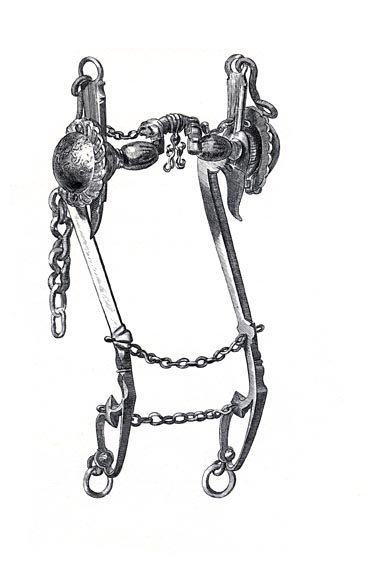
The actual amount of contact likely to occur when mediated by a curb bit like this is perhaps very different from what we today might consider ‘contact’.
La Guérinière then proceeds to outline the sophisticated series of movements he rode: the Volte, the Passade, the Pirouette, the Terre à Terre, and the various airs above the ground.
It would seem also that this eighteenth century maestro at least had some idea of that troubling first principle of the modern training scale, variously known as ‘relaxation’, or ‘submission’ or ‘losgelassenheit’. La Guérinière seems to have a good handle on it, pointing to an earlier French master, de la Broue.
“De la Broue could not give a more exact description of a well-dressed (trained) horse than by saying that he is the one who shows suppleness, obedience and accuracy; the reason being that, if a horse’s body is not completely free and supple, he will not be able to respond to man’s demands with ease and with grace. Suppleness will always result in docility, because the horse will thus not have any problem in performing what is demanded of him.”
To achieve a ‘well-dressed’ horse required the ‘three essential qualities which comprise what is known as a well-adjusted horse.’
The first – suppleness – could only be developed in trot, because to achieve the first quality he must ‘vigorously work all the parts of his body’.
“It is through the trot, the most natural of all the gaits, that the horse is made light to the hand, without having his mouth spoiled, and stretches his limbs without risk of injury.”
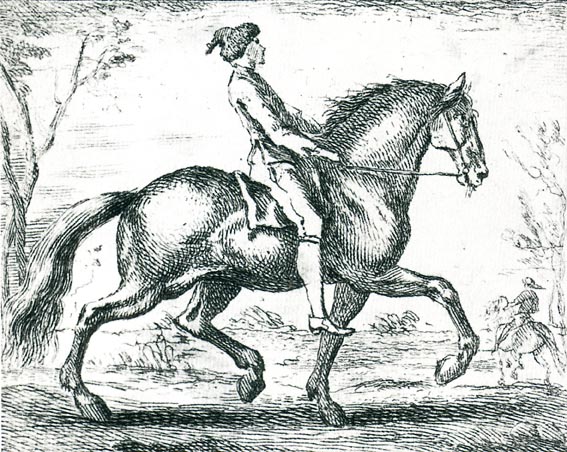
This is la Guérinière’s idea of a forward trot, I can think of a number of modern dressage riders who wish their passage was as elevated…
The next quality is obedience, and this first involves getting the weight of the horse onto his hindquarters. To counter-act the natural tendency of the horse to fall on his forehand, de la Guérinière has the rider perfect the halt, the half-halt and the rein back. La Guérinière notes that many horses will find the halt too physically demanding but the half halt is appropriate to all: “This action does not make the horse as anxious and stabilizes his head and haunches with less constraint than does the halt; it is for this reason that the half-halt is more useful in making the horse’s mouth and achieving lightness.”
more below
Again rein back is to be used sparingly and indeed when the horse has mastered the rein back ‘the best lesson that one can give to make him light in the hand is to only rein back the shoulders, in other words, to gently bring the forehand back to oneself as if one wanted to back him, and when one feels that the horse will back, one must give him the reins and walk forward one or two steps.’
Now we move on to the most important of de la Guérinière’s discoveries: the Shoulder-In, and its close cousin, Haunches out, or The Croup to the Wall. Once again, the aim was to develop the first two qualities of a dressage horse – suppleness and obedience.
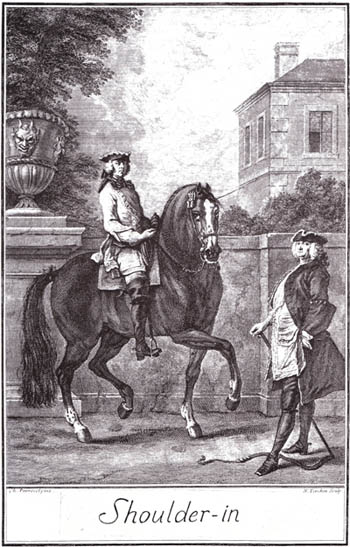
Our old friend, the late Henri van Schraik, this to say about la Guérinière and Shoulder-in:
“The controversies around shoulder-in will very likely never end. Therefore, I think it might be a good idea to go back to the source and find out what de Ia Guérinière really said.”
And Dr van Schaik warned that this was not as simple as it might seem:
“Unfortunately, a genius on horseback is not necessarily a master of language. In his use of language, de Ia Guérinière was not very disciplined and this provoked misconceptions and caused Parocel, his illustrator, to draw the wrong diagrams.”
“To understand the aim of de Ia Guérinière when he conceived the idea of shoulder-in, one should read very carefully what he said in explaining how the concept of this movement developed. In the beginning of the chapter he states that trotting on the straight line results in only limited suppleness, as it helps the forward movement of the shoulders and the legs.”
“The difficulty starts he says, when we try to supple the horse so that he can make circles and sideways (lateral) movements.”
more below
It was the Duke of Newcastle, another of the great Nineteenth Century Masters whose theories were to greatly influence la Guérinière when he developed the shoulder-in movement.
“This can be seen in École de Cavalerie, where de la Guérinière frequently quotes the Duke of Newcastle and then adds his own comments. Several examples are included here. The head-in, the haunches out, on the circle, brings the horse on the forehand… The shoulder cannot become supple if the inner hindleg does not come close to and in front of the outer hindleg.”
“Following these quotations de la Guérinière says: ‘This admission, which experience confirms, makes it very clear that the circle is not the true means to supple the shoulder… a profound truth that this illustrious author admits is that the shoulders can only be suppled when the inner hindleg comes close to and in front of the outer hindleg; it is this judicious remark that has put me on the way to find the exercise shoulder-in.’”
“Now follow two quotations from de la Guérinière himself about the advantages of shoulder-in (bracketed words I have added to aid comprehension). ‘This exercise supples the shoulders because the inner foreleg moving forward, crossing over the outer foreleg, and the inner (hind) foot moving in front of the outer (hind) foot, coming down in the line of that foot, causes the shoulder to make a movement that activates the joints of this part of the horse’s anatomy.’”
“Later he adds: ‘Shoulder-in prepares the horse to bring more weight on the haunches, because during every stride he makes in this position he brings the inner hindleg forward under the mass and puts it in front of the outside hindleg, which he cannot do without dropping the inside hip… thus he learns to flex his hocks.’ A little further on one reads: ‘The line of the haunches close to the wall, the shoulders about one and a half to two feet from the wall.’ By contradicting himself repeatedly in École de Cavalerie, de la Guérinière has created confusion about the movements of the legs and about the question of how much the shoulders should go off the tracks.”
“In the edition published in 1751, on page 107, he first quotes the Duke of Newcastle, when he says that the shoulder cannot be suppled unless the inner hindleg moving forward comes close to the outer hindleg; then Guérinière says that the inner front leg crosses and moves forward over the outer front leg (“croiser et chevaler par dessus”), and in the same way the inner hindleg over (“par dessus”) the outer hindleg. In connection with this sentence, he refers to the diagrams (showing very definitely the stepping over): then, when he enumerates the advantages of the movement shoulder-in, he states: ‘In the first place this lecture supples the shoulders, because the inner foreleg crossing and moving forward over (‘par dessus ‘) the outside foreleg and the inner hindleg moving in front of (‘au dessus’) the outside hindleg and on the line of that same foot; the movement the shoulders have to make, activates the movement of the joints.”
“In the second place: ‘Shoulder-in prepares a horse to put more weight on the hindquarters because during every stride he brings the inner hindleg under his belly and puts that leg in front (‘au dessus’) of the outer hindleg, which causes a flexion of the inner hock.'”
“One gets this picture: the haunches go straight along the wall, with the inner hindfoot in front of the outer. The inner hindfoot should not cross over the outer, because this causes the haunches to swing out, becoming leg-yielding. The shoulders are brought in, not the head, because, as the Duke of Newcastle had to admit, this brings the horse on the forehand. The inner foreleg crosses the outer foreleg, the rider sees the shimmer of the horse’s eye (flexion), the horse is bent around the inside leg of the rider, and the horse is not looking in the direction he is going. The hindquarters propel because they move straight.”
“Of course, one can only begin to ask the horse for shoulder-in after he has become obedient to the leg, and one should realise that one can only gradually get the horse to correctly execute shoulder in.”
“The Germans speak first of shoulder-fore, with which they begin the schooling. In it, the print of the inner hindfoot is between the prints of both front feet. As the horse becomes more supple, the shoulders will be able to come more in, because the horse will be able to bend and the print of the inner hindfoot will cover the print of the outside front foot.”
“Before asking for shoulder-in, the rider should prepare his horse by putting him in position, seeing the shimmer of the inside eye by giving gentle indications with the inside rein; the inside leg should be closed, just behind the girth. (If the leg is too far back, the horse cannot bend around the leg.) The outside leg is passive but ready to prevent the haunches from swinging out (causing leg-yielding). The outside rein, held in a hand a little higher than the inside pushes the shoulders gently to the inside of the track. The hand should never go over the neck.”
“In case the horse brings the shoulders too far in, then the inside hand pushes them back. When de la Guérinière was trying to find a way to loosen the shoulders and hit on the concept of shoulder-in, he got as a bonus something he was not looking for, the flexion of the hocks. Thus shoulder-in not only became a loosening exercise, but also a collecting exercise. Shoulder-in is the pre-eminent exercise to get the horse to flex the hocks, without which no real collection is possible.”
more below
La Guérinière then goes on to discuss the various airs above the ground, use of the pillars, etc, none of which is of great relevance to us today.
What I hope is apparent by now, is that while de la Guérinière had developed an extremely sophisticated system of training focussed on the collected movements, there are various elements, or principles, that are lacking in his school, if you want to produce a horse capable of successfully completing a modern dressage test – the elements are primarily in the area of forwardness and straightness, in the adjustability of the frame.
In all the engravings of the period we see a horse in a frame, the outline of his neck and head never varies, even on the very loose rein, the horse stays in that very collected outline.
The very first illustration of what we would regard as an extended trot, comes with Ferdinand Baucher, in the latter half of the nineteenth century.
Ask a child to draw a horse, and you will very likely receive a drawing of a horse in extended trot – it seems a very simple movement to illustrate. Think of all those engravings of the old masters, can you think of an extended trot? No, because they didn’t use that movement in their school work – it is only in his discussion of the war horse and the hunter that de la Guérinière talks a little about the need to move forward.
It is a relief that de la Guérinière, puts to rest that most present of equestrian myths, that the movements of dressage were designed for the battle field.
Stop and think about it for a moment. To even ride a Novice test seems to require total silence and absence of distraction – imagine your chances of collecting the horse and aiming a capriole at one of the enemy as cannons fire, swords clash and the battle rages.
La Guérinière himself concedes: “If the airs above the ground offer no advantage for war, they offer at least that of imparting to the horse the agility it requires to clear hedges and ditches, which contributes to the safety of the rider.”
Really the great thing François Robichon de la Guérinière contribued to the development of equestrian thought was the awareness that there must be equestrian thought – that riding without guiding principles was just plain wrong.
“Practice without true principles is nothing other than routine, the fruit of which is strained and unsure execution, a false diamond which dazzles semi-connoisseurs often more impressed by the accomplishments of the horse than by the merit of the horseman… This dearth of principles renders pupils unable to distinguish shortcomings from perfection. They have no other recourse but imitation.”
Publications:
Ecole de Cavalerie (1729)
REF: The integration of the Baucher system in the Classical School of de la Guérinière by Miguel Tavora
REF: The Classical Tradition – Out of the Dark Ages – Riding as Art – The Masters of High School by Chris Hector

